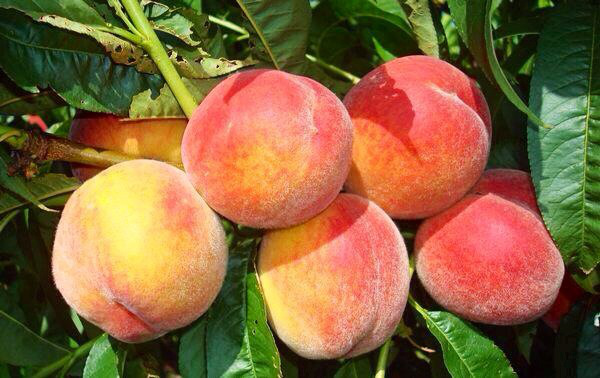Planting, growing and transplanting in areas of high-risk farming such a capricious southern crop as a peach is a difficult and nontrivial task.
Many gardeners, after the first unsuccessful experience, refuse further attempts. And in vain. Most of the misunderstandings can be avoided with proper approach to the tab of the peach orchard, already at the stage of planting seedlings.
Table of contents
When is it best to plant a peach in autumn or spring?
This is a problem around which many copies are broken. There are two options - spring and autumn, and each has its own advantages and disadvantages.
| Season | Merits | disadvantages |
| Spring | During the summer, the seedlings have time to take root and the risk of freezing of the immature root system is reduced. | · In hot summer, the sun's rays can dry the bark and buds. It takes a lot of effort in shading and maintaining constant moisture around the planting.
· A fragile seedling is susceptible to pest attacks. · When purchasing a sapling in spring, it is more difficult to assess its condition. |
| Autumn | · Rooting goes to a period of rest, when a young plant is not disturbed by diseases and pests.
· The sapling is not dried up by the sun. · Sleeping shoots do not detract from the developing roots. · In the autumn to purchase seedlings cheaper in price. · When choosing a seedling, it is possible to assess its condition by vegetative shoots. |
With the early onset of cold weather, seedlings are more at risk of freezing. |
Such a brief analysis shows that autumn planting has more advantages. However, the main factor determining the optimal time is the climate zone.
If autumn is warm, you can plant a peach in September. 6-10 weeks before the frost he will have time to start and prepare for winter. If early frosts and cold are predicted, it is better to keep the purchased seedling until spring in the prix and plant in March, when the temperature of the topsoil will be + 12⁰С.
In the southern latitudes (North Caucasus, Nizhnevolzhsky and Central Chernozem regions), peach is planted, of course, in the fall, until mid-October. In areas with a difficult climate (the Northern region, the Urals, Siberia, the Far East), the landing should be only spring.
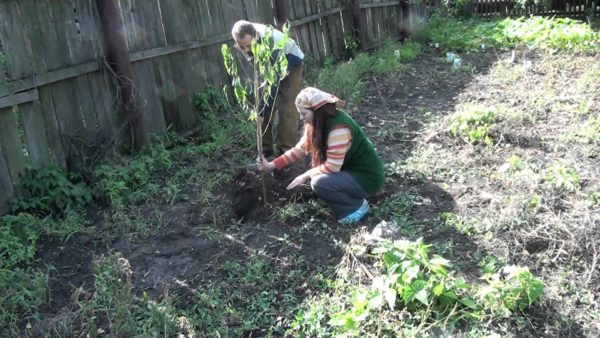
What peach to plant?
Selection of seedlings - one of the most crucial moments. The success of cultivation is influenced by three main factors: variety, stock, seedling condition.
Variety selection
Everyone knows that varieties must be zoned for a particular cultivation region. The problem is that of the 57 peach varieties registered in Rosreestre, all 57 are recommended for cultivation only in the south of Russia.For the Central or, for example, the Far Eastern regions there is no suitable peach. Therefore, to choose a grade for this landmark will not work. What to do?
In addition to zoning, there is also the concept of acclimatization. It lies in the fact that the variety transferred from another climatic zone, with the help of special agrotechnical techniques, takes root in the new conditions. In other words, the tree should be born where it grows. Find acclimatized peaches only in closely located nurseries. Writing seedlings on the Internet and carry them for thousands of kilometers makes no sense.
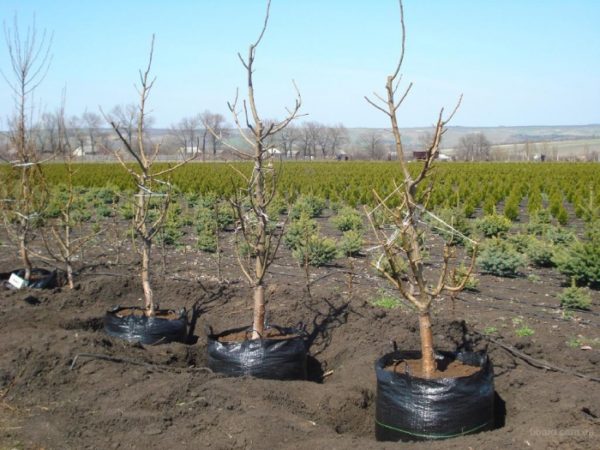
Choice of stock
The stock determines a lot: the viability of the plant, its yield, resistance to diseases, durability, and even future sizes.
Stocks can be vegetative and generative. Vegetative obtained from cuttings of plants with the desired properties. Generative - seedlings grown from seeds.Vegetative rootstock is always safer, generative less predictable.
The main criteria for stock are as follows:
- winter hardiness;
- excellent compatibility with the graft;
- ability to adapt to different soils.
As a peach stock, several plant species can be used:
- apricot;
- bitter almonds;
- cherry plum;
- Manchurian peach.
For growing in areas of risky farming, it is best to take a sapling grafted onto a Manchurian peach. It is this stock that is well rooted in any kind of soil, has increased winter hardiness and drought resistance, makes the future tree compact and resistant to bacterial cancer. In addition, peach fruits on such a stock do not tend to shredding.
Seedling condition
Biennial seedlings are most successful. When buying, you should inspect the plant according to this scheme:
- Inspection of the root system. It should be fibrous, strongly branched, not overdried. The more powerful the root system, the better the plant will be applied.
- Inspection of the trunk and branches. Normal growth "dvuhletki" - from 1.2 to 1.5 meters. The thickness of the trunk is about 2 cm. The distance from the root collar to the vaccination site is 6-8 cm.Well developed lateral branches - at least 3.
- Inspection of the cortex. It should be smooth, glossy, without cracks and peeling. In no case should there be traces of gum.
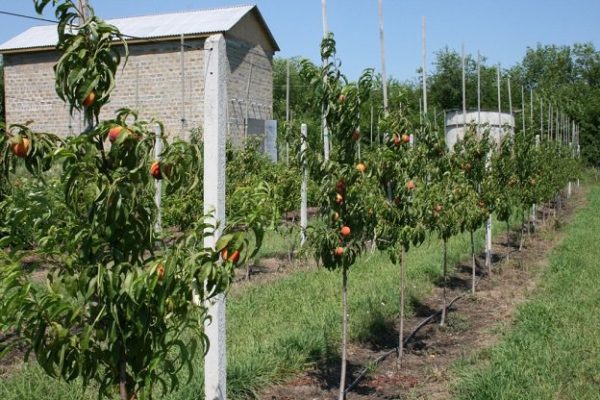
If the seedling is purchased in the fall, there may be leaves on it. On them it is also possible to judge a condition of a sapling. Twisted leaf plates, dried, affected by congestion and other fungi - a reason to guard.
Seat preparation
Peach is an extremely thermophilic and light-demanding plant. When choosing a site for planting, it is necessary to immediately cut off all lowlands, windy, flooded and boggy places, areas with high standing of subterranean waters, places obscured by tall buildings or mature trees.
The best options are any well-lit places covered from the north: the southern wall of the house or the slope of a gentle hill.
If the seedling is planted on the site where garden plants were previously cultivated, you need to keep in mindthat the peach is not suitable as precursors of any plant of the family of solanaceae, melons, as well as strawberries and sunflowers.
The general scheme of preparation of the landing pit is as follows:
- The minimum dimensions are 0.5 * 0.5 * 0.5 meters. If the root system has powerful dimensions, the size can be more - 1 * 1 * 0.8 meters. On wet soils, the depth increases by 20 cm. Additional space is filled with expanded clay.
- The earth, taken out of the pit, is separately mixed with two buckets of good humus and a liter jar of wood ash.
- In the bottom of the pit close to the center, you can hammer support.
The peach tree makes a lot of nutrients out of the soil, and filling the planting pit with fertilizers is a must. In addition to pure organics, you can add mineral complexes. For example, "Kemira Lux" or "Nitroammofosk." In this case, it is necessary to ensure that the root system does not receive a chemical burn, and sprinkle the mineral fertilizers with a layer of soil before planting the seedling.
Two ways of planting peach
In recent years, there have been many discussions between gardeners on the issue of deepening the root collar of peach seedlings. It is believed that the recessed landing increases the frost resistance of the tree. Some peach drivers go further and advise not only to deepen the neck, but also the place of vaccination.
However, in this case there is a risk that the graft will go to its own roots, and all the positive qualities of the stock will be lost. Therefore, the expediency of dropping vaccinations is questionable.
There are two standard technologies of landing: "on a cone" and "in liquid".
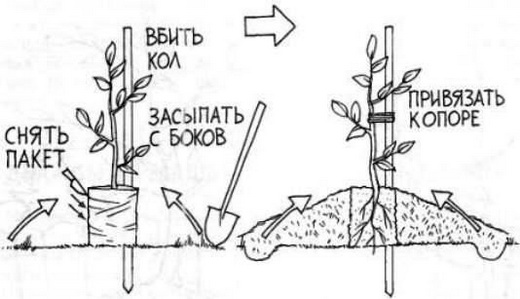
Put on a cone
Putting "on a cone" is not difficult. This is the most common method. The procedure for landing is as follows:
- 2 buckets of water are poured into the landing pit.
- After being absorbed into the bottom of the pit by a knoll, the soil prepared in advance according to the above scheme is poured.
- The seedling is set on the top of the hill ("cone"). The roots are laid out on the slopes so that their location was at an angle of 45⁰.
- Constantly controlling the position of the root collar, the pit is filled with fertile soil, slightly tamping, so that there are no air cavities around the roots.
- Pistol circle is watered with 1 bucket of water. When absorbed, the entire area of the circle is mulched with humus, peat, crushed bark.
After planting, the seedling is fixed to the support, so that it does not tilt when the ground settles in the pit and does not break under strong wind.
Landing "in liquid"
This method is good because it allows you to land alone. The algorithm of action for planting a peach "slush" is as follows:
- At the bottom of the landing pit 2 buckets of humus pour out and filled with a bucket of water.
- When the water is half soaked, the bucket of fertile soil is filled up.
- The root system of the sapling is immersed in the formed slush. Viscous mass holds it well in an upright position.
- The pit is gradually filled with soil. As it fills, the sapling behind the stem pulls up higher. The roots themselves are located at the right angle.
- When the pit is filled, the position of the root collar is checked and another watering is performed.
Pristvolny circle should be mulched. Layer thickness must be at least 7 cm.
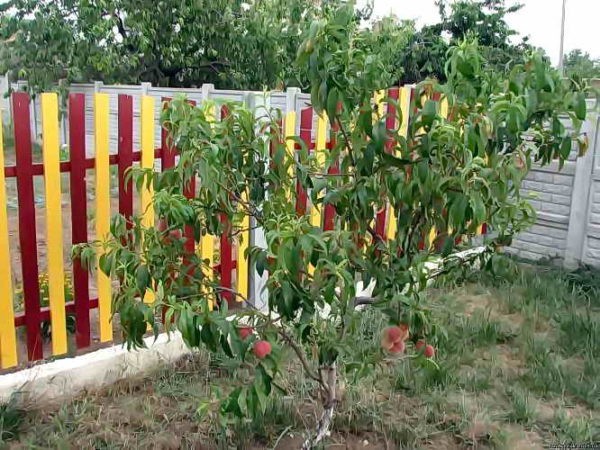
A special case is stansevy peach.
In the northern regions, in Siberia and the Far East, it is advisable to form the stanthus forms of peach. In this case, the landing is as follows:
- Dig a planting hole with a diameter of 120 cm. The depth is small, the thickness of the fertile layer.
- At the bottom of the pit, a mound of earth mixed with humus and superphosphate (250 g) is poured. Nitrogen fertilizers do not make.
- The seedling is placed on a mound so that the top does not touch the ground and is directed to the south.
- The pit is filled with fertile soil, following the position of the root collar - it should be buried no more than 3-5 cm.
- A thicker layer of soil is poured over the root system to prevent it from freezing.
After planting, the seedling is well watered and mulched with a layer of organic matter.
Departure after landing
The main mistake that novice peaches make after planting is to leave a lot of lateral shoots on the seedlings. When spring planting - this is a direct path to the death of the seedling: the vegetative ground part will evaporate too much moisture, which will not have time to fill the broken root system.
In the fall, post-plant pruning is not so crucial. You can make it in the spring, according to the results of wintering.In any case, the operation is performed as follows:
- Choose 3 strong side shoots at a height of about 0.5 m and slightly higher. The center conductor is shortened over the upper branch.
- Lateral branches are shortened by 2 buds. The top must look outward in order to form an open crown in the future.
- All excess side shoots are cut.
When planting in autumn it is also necessary to take care of sheltering a peach. To do this, you can build around the tree structure of 3 layers of dense agrospan. Tent roofs made of reeds or corn stalks will do well. It is better not to use straw mats - they often get rodents.
If the planting pit is filled with fertilizers, peach dressing will not be needed for two years. But to whiten the stambic is: whitewashing will protect the delicate bark of the plant from frost breeze.
You can grow a peach tree not only in the south. If you correctly approach the selection of varieties, to the preparation of the seedling and its planting, even in more northern latitudes, a couple of years later, the peach will delight the owner with amazing fruits. The main thing - the right care and faith in a successful outcome.
